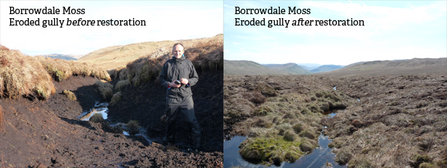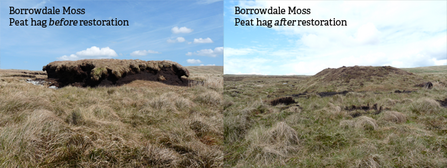Borrowdale Moss
Blanket bog at Borrowdale Moss, between Kendal and Shap, is scattered across 8 km2, at altitudes ranging from 400 to 650 m above sea level, and includes the heads of two glacial valleys.
Restoration area: The peat is on flatter ground, mostly on the tops of the fells, but also in valley bottoms. The rest of the site has steeper valley sides and valley bottoms, with mineral soils vegetated by grass and rush, plus rocky outcrops on the fell tops. The peat deposits range from 50 to 250 cm depth, with an average of about 100 cm, though rather deeper in the centre of the site.
Landowner: Private ownership
Conservation status: County Wildlife Site
Restoration cost: £171,000
The problem: The vegetation was degraded, with deergrass and cottongrass appearing to have spread at the expense of sphagnum moss and dwarf shrubs. There was extensive micro-erosion, leading to gullying and hagging, thought to be due to heavy grazing in the past. The majority of the erosion features on site were vertical peat faces (hags), including simple linear hags and island-shaped features. There were also erosion gullies present, and small areas of bare peat, or ‘peat pans’, with one particularly large area of bare peat. This all leads to significant peat loss through erosion, as well as increasing the speed of rain washing off the bog, increasing flood risk downstream.
What Cumbria Wildlife Trust did: Working closely with the landowner, we undertook detailed surveys enabling us to accurately map all the erosion features, including the use of high-resolution aerial photographs. Using this information, we were able to produce a detailed restoration plan including costings. This restoration plan was used to secure government funding to address the peat erosion and to tender for the work with local contractors. It is estimated that, in total, the project officer walked over 1,000 miles while surveying the site, overseeing restoration and post-works monitoring.
Using specialist excavators, we re-profiled the steep eroding edges, covering them with turf taken from borrow pits nearby. Sediment traps within erosion gullies were created, allowing them to infill and stabilise. An area of approximately 20,000m2 of bare peat has been treated with a mixture of mosses and other vegetation harvested from on site. In addition, we have undertaken the re-profiling of 48,000m of eroding hag faces, 11,000m of gullies and the construction of sediment traps in 7,300m of erosion gullies.
Benefits: Peatland restoration at this site will help reduce the amount of peat particles polluting rivers below, particularly the internationally important River Kent; it will increase the amount of good quality blanket bog habitat; and it will reduce the amount of carbon dioxide being released into the atmosphere through erosion. Revegetating areas of bare peat and blocking gullies will slow the flow of water from the site, reducing the chance of flash flooding downstream. Raising the water table and making the area wetter will also help a host of rare species that need wet habitats.
Species benefitting: Heather, common cottongrass, hare’s-tail cottongrass, deergrass, cross-leaved heath, crowberry, bilberry, cowberry, cranberry, cloudberry, bog rosemary, bog asphodel, sundew, purple moor-grass, soft rush and sphagnum moss.

Borrowdale Moss before and after restoration.
© Cumbria Wildlife Trust

Borrowdale Moss peat hag before and after restoration.
© Cumbria Wildlife Trust
Take a look at our other peatland restoration projects
- Bampton Common Peatland Restoration (https://www.cumbriawildlifetrust.org.uk/bampton-common-peatland-restoration)
- Armboth Fell Peatland Restoration (https://www.cumbriawildlifetrust.org.uk/armboth-fell-peatland-restoration)
- Shap Fells Peatland Restoration (https://www.cumbriawildlifetrust.org.uk/shap-fells-peatland-restoration)
- Tebay Common Peatland Restoration (https://www.cumbriawildlifetrust.org.uk/tebay-common-peatland-restoration)
- Nichols Moss Peatland Restoration (https://www.cumbriawildlifetrust.org.uk/nichols-moss-peatland-restoration-0)
